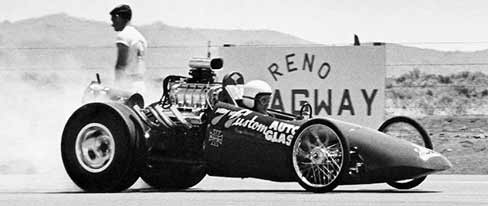|

9/7/04
Reduce the wing & tire,
or lose those blowers

Continued restrictions
on wings, tires and fuel could leave us with
something like the Shoehorn that brave Warren
Welsh of Reno, Nev., campaigned 40 years ago.
One of the first successful back-motored diggers,
the gas-burning Butler & Welsh car clocked
8.50s at nearly 180. (Photo courtesy of Warren
Welsh collection)
It’s a credit to the relative safety
of this sport that the fatal crash of a dragster
driver comes as such a shock, anymore. This
was not always the case The Grim Reaper was
a regular visitor to the pages of Drag News
in the Fifties and Sixties. Causes ranged from
exploding clutches and transmissions to failing
parachutes and roll bars to fires and, yes,
the occasional tire failure. When spectators
become fatalities, as in the infamous Richard
Petty and Huston Platt and Clayton Harris cases,
we held our collective breath, fearing for the
sport’s survival. We don’t want
to go back there.
A simple glance around the grandstands at any
national event reveals that you and I are outnumbered,
anymore, by the “casual fan” or
“TV fan.” These are the guys and
gals wearing polo shirts and pressed pants,
instead of racing T-shirts and 501 Levis. These
are the folks I heard erupt into cheers, even
during qualifying, anytime two fuel cars went
down the track side by side at Sonoma last month—regardless
of whether the scoreboard showed mid-Fours or
Five-ohs. How do you think folks like these
are gonna react when (not IF, but when) some
2000-pound missile slices through the seats
at, say, 350 mph? In those few seconds, professional
drag racing will cease to exist.
Forty or 50 years ago, race-track tragedies
were typically accepted with an attitude of,
“Well, that’s racin’.”
Not even the 11 spectator fatalities at Yellow
River Drag Strip in 1969 could slow the exploding
popularity of Funny Cars. Those days are so
long gone that DRO readers under 40 should be
forgiven for failing to recognize that there
once was drag racing without lawyers, or agents,
or major sponsors.
Nobody ever accused yours truly of being the
sharpest tool in the shed, but whenever I watch
a Top Fuel car’s chassis winding up and
its giant wing bending, in super-slow-mo, I
mentally cross my fingers that none of that
skinny chromemoly tubing will fail. What other
form of race car is known to suddenly break
apart at speed and shoot for the sky, without
contact?
Sure, I’ve looked forward to The Next
Big Number ever since the seven-second “barrier”
was being threatened, but this is not about
what turns me on; it’s about the survival
of something I’ve loved for a very long
time. So, okay, let’s slow ‘em down,
by a bunch. Anyone can see that the current
restrictions aren’t working. Forget about
Band-Aid fixes like nitro reductions, which
only give the megabuck teams another R&D
advantage—and make their motors sound
like weak “girlie men.” Having bounced
back and forth between national events and nostalgia
races for the last quarter-century, I’m
here to swear on a stack of old Drag Racers’
Bibles that a Donovan 417 “on the can”
both sounds and smells sweeter than these 85-percenters
with two-to-three times the horsepower. So does
a modern A/Fuel Dragster, for that matter. Let’s
stop restricting the liquid dynamite, before
the fuel cars sound just like alcohol cars.
The most-discussed solutions involve the same
two factors that every other major racing series
ultimately addresses when seeking to reduce
cost and/or enhance safety: aerodynamics and
traction. To apply either formula to a modern
Top Fuel car effectively, NHRA and IHRA would
be looking at the smaller, single-element wings
and shorter, narrower tires of the mid-Seventies.
Sure, a 300-inch car would look silly with such
a small wing and tires. Moreover, modern motor
and clutch technology applied to such a combination
would quickly result in four-second times at
nearly 300 mph, I predict.
There is another way to slow the speeds down
substantially, without sacrificing either the
cackle or the look: Lose the supercharger! Indeed,
such a combination already exists: Simply remove
the restrictions that keep today’s A/Fuelers
from running away from their blown-alcohol brethren,
and whaddaya know? We’ve got a ready-made
class of slower nitro cars, sans superchargers.
At the same time, let’s remove the huffers
from the Fuel Coupes, too. Visibly, most fans
won’t be able to tell the difference in
either class, so concealed are today’s
blowers beneath bags and bodywork. They’ll
still see flames at night. They’d still
be watching 300-inch wheelbases, big tires and
tall wings go down the track. They’ll
still get four-second runs at or near 300 mph.
Plus, these injected motors “on the can”
would cackle better than today’s 85-percenters
(and much better than future 80-, or 70-, or
50-percent-nitro combinations). Why not announce
it right now, effective with the 2005 Winternationals?
Beyond obvious side effects such as reduced
breakage and downtime and cost, think of all
the fuel dragsters that would suddenly show
up for qualifying! The lost excitement of “bumping
into the show” would return as current
A/Fuel racers battled the suddenly-blowerless
Top Fuel teams. Instead of weak fields separated
by half a second or more between the pole and
the bubble, Top Fuel would be “injected”
with all the qualifying drama and close racing
of Pro Stock. New heroes would emerge. (Let’s
hear it for Keith Stark and Dale Armstrong!)
Now that I’ve committed myself to the
uncomfortable position of slowing down the
cars, let’s move on to speeding up the
show. To move forward in this area, I’ll
be suggesting that we take a page out of drag
racing’s
past, in next month’s column. 
Previous
Stories |
Now
and Then with
Dave Wallace — 8/9/04 (new!)
Other things to do in Indianapolis |
|
|